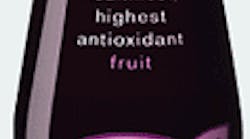A few years ago, to find a wide variety of pure fruit and vegetable juices, you had to go to a health food store. Then something happened: Color became popular. We were advised to "eat a rainbow," and began using words like "antioxidant," and "phytochemical."
Over the Rainbow
The color movement kicked into high gear with the "French Paradox" study. Red wine was good for us and cranberry juice wasn't just for "cleaning the pipes" anymore; they were sources of antioxidants and other phytochemicals. But other hues were included in the nutritional call to color. (We already knew about beta-carotene in carrot juice - it was good for us and made our skin turn orange if we went overboard with the juicer we ordered from late-night TV.)
Today, red couldn't be more "in." Cherry pie cherries are touted for their spectrum of antioxidants (see "Nutrition Beyond the Trends: Pie in the Sky"), berries are popping up in every kind of food or beverage, red carrots became a produce counter attraction and, a few years ago, the luminary became pomegranate juice. Backed by studies showing drinking pomegranate juice may help reverse heart disease, the richly colored, astringent juice is flying off shelves.
Then came the mysterious fruit from South America called the açai (pronounced uh-SAH-ee). With its deep reddish-purple juice, and sour taste, açai is being marketed as the ultimate health fruit. It is packed with tongue-twisting antioxidants.
Açai has always been here. It comes from the same trees hearts of palm come from. They're expensive because of the labor-intensive task necessary to carve up an açai palm. Native to the tropical Central and South American flood plains, the trees are cultivated from Belize to Brazil to Peru. They bear a small, round white or purple-black fruit about the size of a small grape.
The Color Purple
The açai fruit might look like a grape, but it has smaller pulp and only a single large seed, and in South America is often eaten raw or used as a condiment. Because the fresh fruit deteriorates rapidly after harvest, it is generally only available as juice or frozen fruit pulp outside its growing region.
Açai are among the most nutritious foods of the Amazon, rich in B vitamins, minerals, fiber, protein and omega-3 fatty acids. It also contains oleic acid (omega-9), a beneficial fatty acid (often mistakenly referred to as essential).
Potassium is the mineral most abundant in the açai, but it is also rich in copper, and unusually high in manganese. Only a small portion supplies far more than the body needs of this ultra-trace mineral.
The big question, nutritionally, is whether these trendy little purple jewels are a wonder food, as so many marketers claim. The fact is there is enough research to make marketers happy. Experiments conducted at the University of Florida revealed the polyphenolic compounds from açai fruit could significantly slow the proliferation of cultured human leukemia cells. The actions of different compounds in açai appear to be separate, not additive.
Researchers at the Institute of Nutritional and Food Sciences of the University of Bonn, Germany, found the antioxidant capacities of the purple açai to form an excellent defense against three different types of dangerous oxygen radicals, when compared to other fruit and vegetable juices. (The white variety of açai showed very low antioxidant capacities against the same reactive oxygen species - sort of like the red wine-white wine difference.)
The health-promoting compounds identified in the purple açai fruit pulp include two major anthocyanins, cyanidin-3-glucoside and cyanidin-3-rutinoside. Interestingly, the anthocyanins accounted for only about 10 percent of the overall antioxidant capacities of the fruit. Two things were obvious: First, compounds not yet identified are responsible for the major part of the antioxidant capacities of the açai fruit pulp. Second, the power resides somewhere in the purple.
Rating the Power
Anthocyanins provide antioxidant power to a variety of natural foods with a red or purple hue, like red cabbage, berries, plums, and apples. But they are more than just natural antioxidants. They are also powerful anti-inflammatory agents that act in ways like the drug ibuprofen, but without side effects.
Açai fruits are one of nature's richest sources of these dual-protection compounds. Because there is more to antioxidant power than one compound, a rating system is often used to measure the antioxidant power.
The Oxygen Radical Absorption Capacity (ORAC) assay measures the total antioxidant activity of a biological sample. It's used in human, agricultural, food and pharmaceutical products, as well as food ingredients.
For the average person to cope with all the reactive oxygen species they will encounter, foods and beverages totaling an ORAC value of about 1,670 per day are needed. It's been estimated that 80-90 percent of the world's population fails to consume even half of this level. At 3,800 ORAC value per gram, açai provides levels multiple times that of other anthocyanin-rich fruits and vegetables, such as cherries, cranberries and mulberries.
The resulting proliferation of açai products is still focused in the beverage category so far. New companies such as Bossa Nova Beverage Group Inc. (www.bossausa.com), Los Angeles devote themselves fully to açai-based beverages, while established premium health and juice beverage makers enhance already popular lines with new blends using the berry, such as the new Purple Machine "superfood smoothie" from Naked Juice Co. (www.nakedjuice.com), Azusa, Calif.
One of the first to bring açai to the U.S., Sambazon (www.sambazon.com), San Clemente, Calif., provides the ingredient (pulp and powder) and retail açai beverages using only organic, fair trade product.
So açai juice appears to be the "real deal," or at least as real as any other deeply hued fruit. At the very least, it merits more study. Does that make it a superfood? I guess that depends on how you view nutrition. Compared to a junk food meal straight out of the deep fryer, washed down with non-nutritious, high-calorie beverage - all too common today - yes, it's a "superfood." But shouldn't colorful, nutrient-dense foods be the norm?


